Cost of LPN Programs & Schools
Becoming a Licensed Practical Nurse (LPN) is a rewarding career choice that can be achieved in a relatively short amount of time. If you’re considering LPN school, this guide will walk you through the key factors to evaluate, how to prepare for admission, and what to expect from the program and profession.

Written by Jane Dewy and Edited by The PracticalNursing.org Editorial Team.
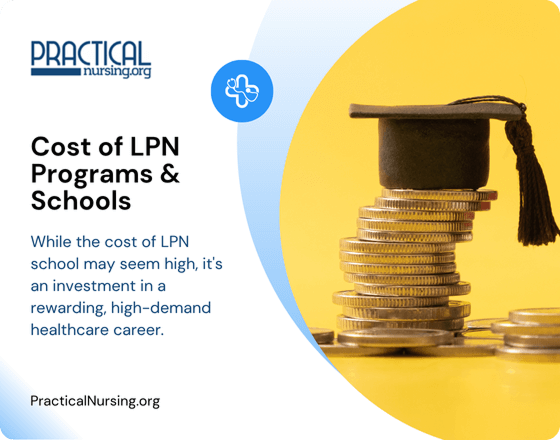
Cost of LPN Programs & Schools
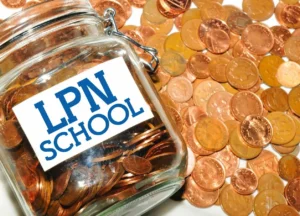 LPN Program Tuition
LPN Program Tuition
The largest portion of your LPN program cost is tuition. This can vary widely depending on state and locality. Tuition most often refers to the cost of classroom education a program gives. This often does not include various costs necessary to complete a program, such as books or clinical fees.
 Monetary Costs of LPN School and How to Save
Monetary Costs of LPN School and How to Save
Paying for nursing school can be confusing and even overwhelming. One thing that compounds this problem is the loose definition of “tuition.” As previously mentioned, this often only applies to the price of classroom time or actual education provided. Some LPN programs combine all costs into one figure (tuition, books, fees, etc). However, for most practical nursing programs, this is not the case.
In addition to tuition, the student is often responsible for other mandatory fees and costs. Here are some of the most common expenses associated with LPN school (besides tuition):
- Books – A necessity for any educational program, and LPN programs are no exception. Depending on individual program requirements and course load, books can cost several hundred dollars to over $1,000. One tip for saving money is to shop around for textbooks and other required materials. Vocational schools and universities often have their own bookstores, but items sold there can be more expensive. Be sure to check out some alternatives for buying books, such as Amazon or eBay. Another interesting idea for saving money on textbooks is chegg.com. This service offers textbook rentals and electronic downloads of books. This can be an efficient option for those planning to resell books after finishing school. There are two important things to ensure while shopping around for textbooks: 1) make sure the ISBN matches! (this number is different for each book) 2) be sure to buy the correct edition! Changes in a textbook can vary greatly depending on edition number; even page numbers change.
- Stethoscope – This is an inevitable cost for all LPN students, and especially licensed nurses. They facilitate correct assessment of patients and can lead to valuable information. Because a stethoscope is such a valuable tool, put some thought into buying one. Stethoscopes can be bought as cheaply as $20 or as pricey as hundreds of dollars. This is one instance in which you literally get what you pay for. Cheap stethoscopes are in no way equal to their nicer counterparts. Cheap stethoscopes make proper assessment of patients hard, especially for beginners’ ears. They do not carry sounds as effectively or as loudly, which can lead to missed observations. Use a cheap stethoscope and then a nice one – the difference will be clear. For one particularly good brand of stethoscope, check out Littmann® Stethoscopes. “Good” stethoscopes can be bought in-store or online for around $100; “great” ones for about $150+. Stethoscopes come in a variety of colors and styles. They can even be engraved with a nurse’s name or a message.
- Uniform and Nursing Supplies – Uniforms usually consist of scrub pants and tops. Color and styles vary by school, as well as uniform supplier. Some schools require certain types of scrubs, so be sure to check. Uniforms may be as cheap as $25 or as expensive as several hundred dollars. Some LPN programs require a certain number of uniforms to be purchased. After uniforms, the two most common examples of other nursing supplies are the pen-light and bandage scissors. Luckily, these items are often cheap (about $10 each) and may even be provided by the school. A pen-light is vital for assessing pupil size and completing patient neurological checks. Bandage scissors or shears are useful for a variety of purposes, the least of which involves removing bandages. Other useful products include “Pocket” LPN Guides and clipboards or organizers. These can be valuable resources in clinical settings. Some even have built-in calculators or other tools. Shop around and find ways to stay organized!
- NCLEX-PN Testing – The NCLEX exam must be taken by all LPN program graduates to obtain licensure. The cost is around $200 and is often not covered by the LPN school. In addition to paying for the actual exam, it is a good idea to prepare adequately! Review books or courses can be purchased and often help students pass the first time. Repeat examinations must be paid for at the full fee, which can get expensive. Refer to our handy NCLEX-PN process guide for further information.
- Fees – This is the most vague and farthest-reaching category. “Fees” can range from $0 to thousands of dollars. Common fees include clinical fees, technology fees, parking fees, cafeteria fees, etc. Review fees and other financial information from your chosen school to get a better idea.
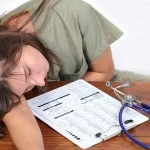
This is not as much of a cost of LPN schooling but a consequence of it. However, the end result is still less money. Many prospective licensed practical nurses have jobs that they cannot afford to quit while in school. This leads to a predicament. See our piece on working during LPN school. Working during practical nursing school can be extremely hard, especially with full-time LPN programs. Often, students do not have a choice and cannot afford to quit their jobs entirely. However, hours should be cut back. This leads to lost income and should be prepared for if possible. Make a budget and prepare for LPN school. Find a balance and devote as much time as possible to school and nursing education.
Personal (Non-Monetary) Costs of LPN School
There are other “costs” of LPN school that should be considered and managed appropriately. School can be both mentally and physically exhausting; it can drain our batteries. While in school, things such as lack of sleep can lead to stress. Having less time to spend with friends and family due to studying or long clinical hours may be a reality. Make the most of time with family and other support systems while in school. Read great tips on how to take care of yourself during nursing school.
Ways to Pay for LPN School
LPN programs can be expensive. Ranging from $5,000 to $25,000 or more, nursing students are often left wondering how they will be able to pay for LPN school. There are several different ways to pay. Each has its own advantages and disadvantages. Often, several methods are combined to cover the costs.
Cash
Cash is a fast and simple way to pay for LPN school. There is no interest and no obligation to pay money back in the future. However, for many students, this is not a realistic method. Often, when applying for student aid, there are small remainders of tuition and costs left for the student to pay out of pocket.
Grants
Grants are a form of financial aid that does not normally have to be repaid. Grants are sometimes called “free money.” Grants can come from federal or state governments. They can also come from companies, organizations, colleges, or individuals. Grants are usually need-based, meaning are given out based on financial need. Because grants are “free money,” they often have application deadlines and certain requirements. In addition, some grants may have to be repaid if the student withdraws early. As with any financial aid or assistance, be careful to avoid scams and illegitimate providers.
The most well-known grant many students receive is the Federal Pell Grant. Currently, the federal Pell Grant amount is based on financial need, cost of education, enrollment status (full or part-time), and how long the student plans to attend school. As with most other financial aid options, there are several methods the money may be handled. Usually, schools receive grant money and apply it directly to costs, then pay the student the remainder if there is one.
Loans
A loan is a sum of money that is borrowed. The borrower must pay this money back, plus any interest accrued. Interest may be fixed or variable depending on the loan and who loans the money. Two main types of loans are available to students: federal student loans and private student loans. Federal student loans are funded and sometimes subsidized by the federal government. Private student loans are given by banks, credit unions, educational institutions, or certain state or local agencies. There are several differences between these two types of loans. Private loans often have higher interest rates and are unlikely to be subsidized. For most students, it makes more sense to obtain federal student loans if possible. These loans have fixed interest rates that are lower than other private loans. With federal student loans, it is not necessary to make payments while in school.
Many qualify for subsidized loans in which the government pays for the interest on a loan while enrolled at least part-time in school. Unsubsidized federal student loans keep track of interest while the student is in school. Then, before the repayment period starts, the accrued interest is added to the original loan amount. The borrower is now responsible for this new principal amount plus interest. This is called capitalizing interest.
There are limits to the amount of federal student loans you can borrow. This generally goes up each academic year and is also higher for independent students, as opposed to those with dependent status. Federal student loans are a form of financial aid available directly to the student. Although the money must be paid back, along with some interest, education is a valuable investment. Student loans help many to bridge the gap and be able to afford education. Complete a FAFSA form to determine your eligibility.

For more information on federal student loans, visit the official website.
If student loans and other forms of financial aid do not cover costs, other loans can be applied for. Often, these loans can be borrowed by parents directly or with the help of a cosigner.
Work-Study Program
The Federal Work-Study program provides students with part-time jobs while enrolled in school. Jobs may be on or off campus. Money is usually paid directly to the student and can be used to help pay educational expenses. Some schools do not participate in this program; be sure to check.
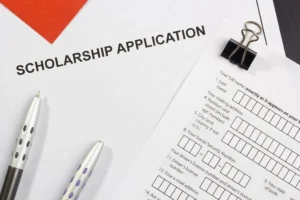 Scholarships for LPN Programs
Scholarships for LPN Programs
Scholarships are similar to grants in that they do not have to be repaid. However, scholarships are usually merit-based, not need-based like most grants. Scholarships are a good option for paying for part or all of LPN school costs. Scholarships are available from many sources and do not have to be paid back by the student. Individuals, groups, private or nonprofit organizations, religious groups, churches, companies, and more offer scholarships.
Be careful and prudent when searching and applying for scholarships online. Some people use fake scholarships to scam innocent victims. Always use reputable sources and search engines when researching possible scholarships. If a scholarship seems too good to be true, it might be. Lastly, be extremely wary of scholarships that ask for payment, credit card information, or social security numbers. These are usually dead giveaways for fake scholarships and scams.
The largest number of scholarships come directly from the LPN program you are applying to. There are usually a specific number of awards each year, and schools pick the applications that stand out as the best. Scholarships require an application completed and turned in with a written essay. The essay should explain why you qualify for the award or need it. If the application is strictly for nursing, the essay should state why you want to become an LPN. When completing the application, a good rule to follow is to take your time and make sure both the application and essay are grammatically correct. Check for errors or misspellings before submitting your applications. Also, have another person read your paperwork. Others may find errors that you may have missed. It is also good to pay attention to deadlines. Most scholarships have a set deadline and will not accept late applications.
Check out our Veterans Guide to LPN Training & Financial Aid > Military Scholarships.
National LPN/LVN Scholarships
FAFSA Essentials for LPNs
FAFSA stands for Free Application for Federal Student Aid; this form is the largest single source of financial aid available for students. Because LPN school can be expensive, student aid is often helpful. Read here to learn about the real cost of LPN school. As the name implies, this application is free to complete and submit. Once submitted, the student will soon know what types of student aid are available to them and how much is available. FAFSA unlocks student aid such as federal grants, loans, and work-study programs. In addition, many state and local agencies or entities can use FAFSA data to determine eligibility for other types of state and local student aid. The FAFSA is good for one school year; a new one must be completed each year you wish to receive federal student aid. Keep this in mind when planning how you will pay for LPN school. There are three options available for filing a FAFSA.
- Apply online
- Download and complete a PDF FAFSA; this is then mailed for processing
- Request a paper FAFSA
Filing a FAFSA online is the fastest and easiest way to obtain student aid for LPN school. The processing timeline is typically 3 to 5 days. Paper applications are processed within 7 to 10 days. Be sure to submit your FAFSA on time!
Requirements for Federal Student Aid
Certain basic requirements should be fulfilled before completing a FAFSA. Below are the eligibility requirements for federal student aid:
- Be a citizen of the United States or be an eligible non-citizen
- Have a valid social security number (SSN); certain students are exempt from this rule, such as those in Palau, Micronesia, and the Marshall Islands
- Possess a high school diploma or GED certificate
- Be enrolled in an eligible program
- Maintain “satisfactory academic progress”
- Not be in default with current student loan
- Have a record free of drug-related offenses
Certain types of grants and loans have other requirements, such as demonstrating financial need. Grade level and degree obtained also affect the types and amounts of available student aid. If you are unsure of anything, contact the financial aid office at your school.
How to Prepare for and Complete a FAFSA for LPN School
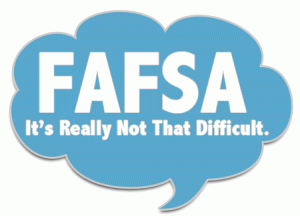
The student, situation, and whether the FAFSA is an initial application or renewal all affect how long it takes to complete a FAFSA for LPN school. Average time is close to 1 hour. Take your time and ensure accuracy. Gathering required information before starting can greatly expedite the process. Here is a summary of what you might need:
- Social Security Number (or Alien Registration Number if not a United States citizen)
- Most recent federal income tax return, W-2, and records of other money earned. FAFSA is linked with the IRS data retrieval tool, which is available for many students to use. This automatically transfers the information from the previous year’s taxes into the FAFSA form
- Bank statements and records of investments (these are often not needed and not applicable)
- Records of untaxed income (if applicable)
- Electronic personal identification number (PIN): This is a secret number that is required as a form of identification and is used to electronically sign the FAFSA. Federal student aid PIN stays the same year to year
- In addition, if considered a dependent student, you will need all of the above information for your parent(s). With the exception of students over 23, married students, military or veteran students, and Master’s degree or Ph.D. students, most everyone else is considered dependent. Visit the official government FAFSA website for complete information.
Filling out the actual FAFSA is easy. Simply input information as prompted. FAFSA will ask for the information listed above as well as other information. While completing a FAFSA, you will be asked which educational institutions you would like FAFSA data submitted. It is a good idea to enter more than one LPN school if you are unsure which school you will attend.
What to Expect After Completing a FAFSA
After completing a FAFSA form, it must be processed. Once the application is processed, you should receive an email notification. You are then able to view your Student Aid Report (SAR). This document summarizes information entered into the FAFSA and should be checked for accuracy. The SAR also contains the Expected Family Contribution (EFC). This number is used in the process of determining student aid eligibility and amounts. This is not meant to be an estimation for out-of-pocket costs or parental contributions. If corrections or additions are needed, they should be completed as soon as possible.
Once the FAFSA is completed, the information will be sent to the colleges and universities listed in the application. Each school is then responsible for creating and disbursing financial aid packages. Some schools require other information; it is always a good idea to check. Usually, student financial aid packages are sent to students around the same time as admissions paperwork, but this can vary from school to school.
Student Aid Deadlines
One very important thing to remember if you are planning to receive federal student aid is deadlines. Be sure to review all applicable deadlines and note the window in which any changes are accepted.

In addition to federal deadlines, many states have additional deadlines required for student aid. Many states have deadlines that are much earlier than federal deadlines, some by more than one year. The government FAFSA website and your college’s financial aid department should be able to answer any questions about state deadlines and other requirements for student aid.
State and federal deadlines are also accompanied by college deadlines. Although these do not apply to all schools, it is important to know. Your college’s website or financial aid department can provide more information about deadlines.
The easiest way to overcome all the deadlines is to submit your FAFSA as early as possible. Normally, as soon as a previous year’s tax return is completed, the FAFSA can be submitted.
Next Guide: During LPN School > LPN Resumes & Job Applications
More LPN How-To Guides
Discover more how-to guides and resources for practical nursing professionals or students that want to further their careers in practical nursing.
Explore how to choose the right LPN program, what to expect from the application process, and how to prepare for success as a future nurse.
Learn the step-by-step process for becoming a licensed practical nurse, from completing your program to passing the NCLEX-PN exam and applying for licensure.
Build a strong LPN resume that highlights your training, clinical experience, and nursing skills with tips, templates, and examples.
Find out what LPNs actually do on the job, where they work, and how their hands-on role fits into the larger healthcare team.
Related Articles
- Beware of the Migraine Fairy – An LPN’s View
- Changing LPN Job Specialties
- LPN Jobs Description
- Top States for LPN/LVNs: Where to Thrive in Your Practical Nursing Career in 2025
- Should an LPN Become an RN?
- Why Getting Your LPN/LVN Degree Can Be a Smart Strategic Move
- Nursling Gone Insane – An Experience Working While in College
- LPN Continuing Education Units